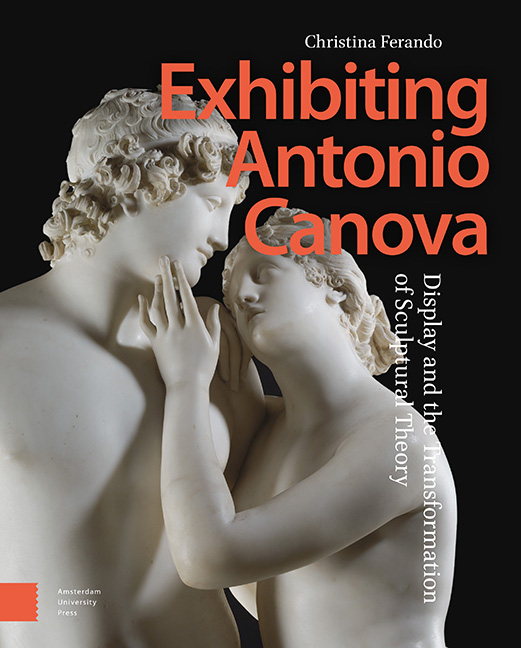Book contents
- Frontmatter
- Table of Contents
- List of Illustrations
- Acknowledgements
- Introduction: Canova on Display
- 1 Imagining Sculptural Practice
- 2 Reevaluating Ancients and Moderns
- 3 Anatomizing the Female Nude
- 4 Challenging the Supremacy of Painting
- 5 Defining Modern Sculpture
- Conclusion: Aftereffects
- Bibliography
- Index
3 - Anatomizing the Female Nude
Published online by Cambridge University Press: 13 February 2024
- Frontmatter
- Table of Contents
- List of Illustrations
- Acknowledgements
- Introduction: Canova on Display
- 1 Imagining Sculptural Practice
- 2 Reevaluating Ancients and Moderns
- 3 Anatomizing the Female Nude
- 4 Challenging the Supremacy of Painting
- 5 Defining Modern Sculpture
- Conclusion: Aftereffects
- Bibliography
- Index
Summary
Abstract: Chapter three, “Anatomizing the Female Nude,” focuses on Canova’s 1812 Venus Italica, which was celebrated as the replacement for the Venus de’Medici after the latter was sent to Paris. After the Venus de’Medici returned to Florence, however, Canova’s Venus Italica was moved from the Tribuna in the Uffizi to the Palazzo Pitti. There, displayed in a “boudoir” surrounded by mirrors, visitors focused on the softness (“morbidezza”) of her flesh. Canova’s viewers mitigated the discourse of seduction and desire generated by soft flesh, transforming their interest into anatomical inquiry. The predilection for “scientific” examination not only reflected the period’s conservative social mores but also reveals how sculpture was implicated in the construction of racial and gender hierarchies.
Keywords: gender, polychromy, race and skin tone, flesh, morbidezza, Venus Italica
The criticism leveled against Canova’s Perseus— that it failed to live up to its antique model—was aimed equally at other works by the artist. His Venus Italica, for instance, was understood as a replacement for the Venus de’Medici, which, like so many other antiquities, had also entered the Louvre’s collections. Installed in 1812 as Canova approached the height of his fame, the Venus Italica raised similar concerns about cultural patrimony, the role of imitation in the production of the fine arts, and the relationship between ancient and modern sculpture. Yet the Venus Italica, like so many of Canova’s female nudes, was also deemed beautiful and graceful; Canova excelled in the genre. The supple surface of the Venus Italica therefore enabled viewers to grapple with the legacy of Baroque “softness,” sculpture’s desirability, and changing attitudes towards the female body and its anatomy.
The Creation of a Modern Venus
Canova’s Venus Italica cannot be understood outside of the context of Florence’s artistic history (Fig. 3.1). While the city lacked the sublime beauty of Naples and the classical culture of Rome, it was the birthplace of Renaissance culture. The city boasted the oldest academy on the Italian peninsula, the Accademia delle Arti del Disegno, as well as what was arguably one of the first “public” exhibition spaces, the Tribuna of the Uffizi. Completed in 1589 and designed to showcase the collection of the Grand Duke, Francesco I de’Medici, by the eighteenth century it was considered a mandatory stop on the Grand Tour.
- Type
- Chapter
- Information
- Exhibiting Antonio CanovaDisplay and the Transformation of Sculptural Theory, pp. 123 - 176Publisher: Amsterdam University PressPrint publication year: 2023



